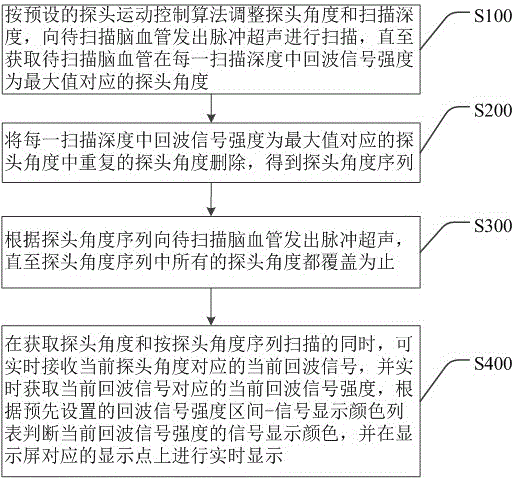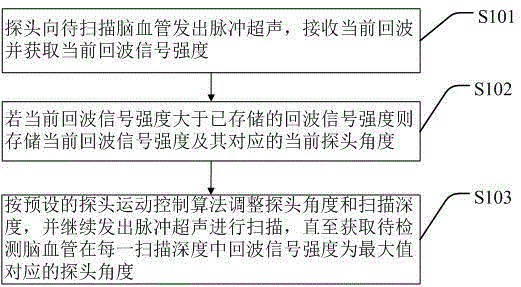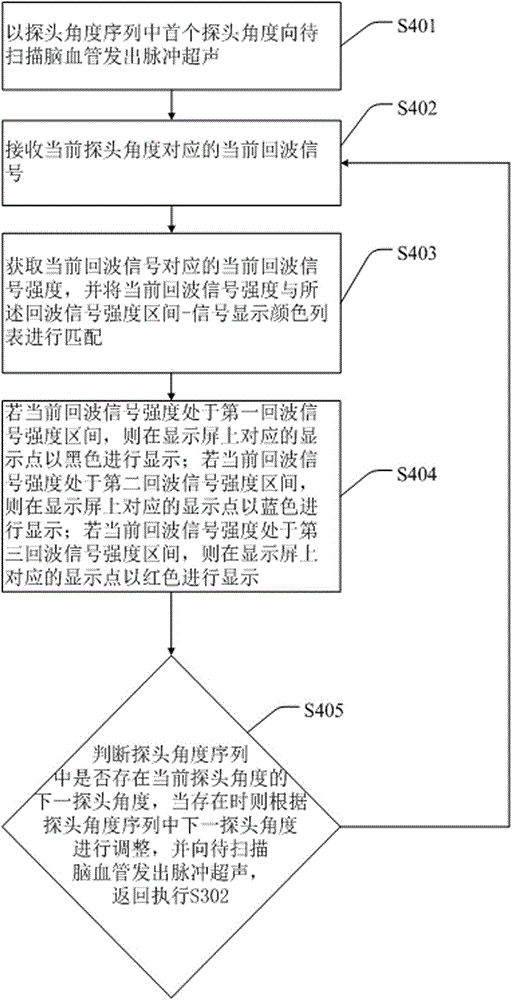Method and system for automatically scanning intracranial cerebral vessels
An automatic scanning and cerebrovascular technology, applied in the field of cerebrovascular positioning and scanning, can solve the problems of lack of cerebral blood flow monitoring function and automatic adjustment function
- Summary
- Abstract
- Description
- Claims
- Application Information
AI Technical Summary
Problems solved by technology
Method used
Image
Examples
Embodiment 1
[0063] Example 1 of the positioning process: locating the left middle cerebral artery (LMCA)
[0064] The surface of the probe is coated with couplant, placed on the left temporal window, and the initial state is perpendicular to the temporal window; the scanning depth is adjusted to 30mm; the scanning is turned on, and the probe starts to rotate; the signal strength is judged in real time during the scanning process, and when a strong signal is found, record the probe Angle; continue to scan, if there is a stronger signal, record the new probe angle; until the scan is completed, record the probe angle at the strongest signal. Increase the scanning depth by 5mm to 35mm, repeat the above process, and record the probe angle at the strongest signal. Thereafter, the scanning depth was increased by 5mm each time until it was at 55mm, and the probe angle at each scanning depth was recorded. Through the above scanning, the sequence of probe angles completely covers the LMCA, and the...
Embodiment 2
[0065] Example 2 of the positioning process: Locating the left anterior cerebral artery (LACA)
[0066] The surface of the probe is coated with couplant, placed on the left temporal window, and the initial state is perpendicular to the temporal window; the scanning depth is adjusted to 55mm; the scanning is turned on, and the probe starts to rotate; the signal strength is judged in real time during the scanning process, and when a strong signal is found, record the probe Angle, determine whether the position is tilted forward and upward; if so, continue scanning, if there is a stronger signal, record the new probe angle, and determine whether the position is tilted forward and upward; until the scan is completed, record the probe at the position with the strongest signal angle. Increase the scanning depth by 5mm to 60mm, repeat the above process, and record the position of the probe with the strongest reverse signal. Thereafter, the scanning depth was increased by 5mm each ti...
Embodiment 3
[0067] Example 3 of the positioning process: positioning the left posterior cerebral artery (LPCA)
[0068] The surface of the probe is coated with couplant, placed on the left temporal window, and the initial state is perpendicular to the temporal window; the scanning depth is adjusted to 55mm; the scanning is turned on, and the probe starts to rotate; the signal strength is judged in real time during the scanning process, and when a strong signal is found, record the probe Angle, to determine whether the position is tilted backwards and upwards; if so, continue scanning, if there is a stronger signal, record the new probe angle, and determine whether the position is tilted backwards and upwards; until the scanning is completed, record the probe at the position with the strongest signal angle. Increase the scanning depth by 5mm to 60mm, repeat the above process, and record the position of the probe with the strongest reverse signal. Thereafter, the scanning depth was increas...
PUM
 Login to View More
Login to View More Abstract
Description
Claims
Application Information
 Login to View More
Login to View More - R&D
- Intellectual Property
- Life Sciences
- Materials
- Tech Scout
- Unparalleled Data Quality
- Higher Quality Content
- 60% Fewer Hallucinations
Browse by: Latest US Patents, China's latest patents, Technical Efficacy Thesaurus, Application Domain, Technology Topic, Popular Technical Reports.
© 2025 PatSnap. All rights reserved.Legal|Privacy policy|Modern Slavery Act Transparency Statement|Sitemap|About US| Contact US: help@patsnap.com



